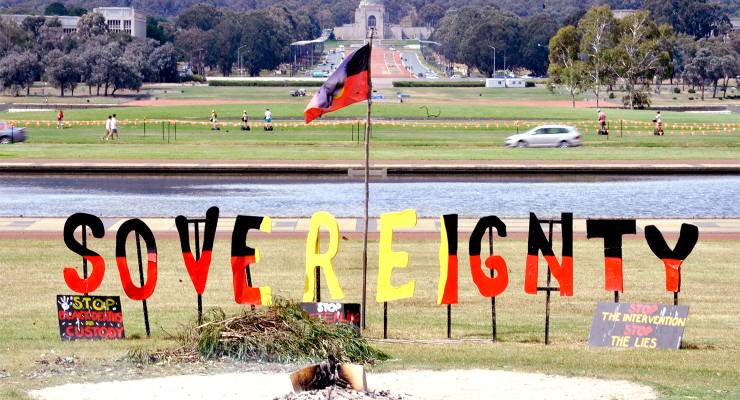
Aboriginal and Torres Strait Islander readers are warned that the following mentions a deceased person.
This is an edited extract from Melissa Castan and Lynette Russell’s Time to Listen: An Indigenous Voice to Parliament (Monash University Publishing).
Until Federation in 1901, Australia was divided into six distinct colonies, each with its own government, set of laws and even military forces. They each issued their own stamps and collected customs, tariffs and taxes. The colonies even built their railway tracks using different gauges, which complicated the movement of goods and thereby trade in general.
The new federal constitution was meant to unite the colonies, but Indigenous peoples were left out of the national embrace, all but forgotten. Federation divided law-making power between the states and the new central Parliament. In this division, Indigenous peoples were left to state management, and were only referred to in the negative, excluded from Commonwealth legislative power, not counted in the census.

Many Indigenous and non-Indigenous Australians have since looked to 1967 as the high point of engagement with, and recognition of, Indigenous status, observing that surely the most substantial and resonant constitutional amendment occurred in that year’s successful referendum. The poll itself was simple. Australian voters listened to Indigenous advocates who sought two key changes to the constitution.
The first concerned the legislative power of the Australian Parliament in section 51(xxvi), which gave Parliament limited power to make laws “with respect to … the people of any race, other than the aboriginal race in any state, for whom it is deemed necessary to make special law”. To be clear, what this meant was that the federal Parliament could make laws that conferred a special benefit, or imposed a special burden, on the people of one race — but not for, as they termed it, the “Aboriginal race”.
Indigenous Australians had been excluded from this provision for two fairly unpalatable reasons. The first was that the states wished to retain control over them. That might seem benign, but state legislation concerning Indigenous Australians was overwhelmingly discriminatory and caused great disadvantage. The second was that they were considered to be a dying race and not worthy of consideration.
State-based protection acts regularly dispossessed Indigenous people of their homes; broke up families, separating children from their parents; and instituted other discriminatory and assimilatory practices. The campaign to change section 51(xxvi) was strongly motivated by the belief that the federal Parliament needed to be given power to make nationwide laws for Indigenous Australians, to redress this discrimination. So the Australian people were asked whether the words “other than the aboriginal race in any state” should be removed from section 51(xxvi).
The second change concerned section 127 of the constitution, which originally provided: “In reckoning the numbers of the people of the Commonwealth … aboriginal natives shall not be counted.” The referendum asked whether section 127 should be removed so that Aboriginal people would be counted in the census.
The 1967 referendum was a watershed moment in Australian race relations and a pivotal moment in the country’s legal history, as the proposed changes were approved by a majority of people, and a majority of states. In fact, 90.77% of those who voted were in favour of the changes. It is unsurprising that these amendments passed as they had bipartisan support; there was no formal campaign to oppose them.
However, in hindsight, it does not seem that the referendum achieved all that was hoped for. Despite the popular movement to address Indigenous disadvantage, there was no significant or immediate change. It appeared that the Australian nation had still not found a way to properly recognise, engage with and include Indigenous nations in the constitutional, legal and political functioning of the state. The fault line had not been repaired.
The first laws made under the new powers were not enacted until the Whitlam government.
Under the Aboriginal and Torres Strait Islanders (Queensland Discriminatory Laws) Act 1975, the federal government legislated to make discriminatory state laws inapplicable by overriding them, thereby attempting to eliminate racial discrimination against Indigenous Australians. It was on 16 August 1975 that Vincent Lingiari, a Gurindji Elder, received a handful of red dirt from then-prime minister Gough Whitlam. Whitlam had scooped up the soil after presenting to the Gurindji people the deeds of a small parcel of their traditional country, then known as Wave Hill Station. Whitlam remarked:
Vincent Lingiari, I solemnly hand to you these deeds as proof, in Australian law, that these lands belong to the Gurindji people, and I put into your hands this piece of the earth itself as a sign that we restore them to you and your children forever.
But although this moment was evocative in terms of land rights, and provided a brilliantly iconic photo opportunity, it ultimately failed to advance political and legal relationships beyond the immediate Gurindji station. The Gurindji people had been heard, but their voice did not echo beyond them. Furthermore, the Gurindji did not get inalienable Aboriginal freehold ownership deeds to the station until May 1986.
Despite the positives of the 1967 referendum outcome, it is important to note that the power granted can be used for any laws with respect to Aboriginal and Torres Strait Islander peoples. It does not stipulate that the laws need to be favourable; in fact, it enables detrimental laws to be passed as well.
The aim of the referendum was to grant the federal government legislative power, but that power has not reliably been used to the advantage of the intended beneficiaries. Indigenous Australians are still disadvantaged, in many ways. Thus the fault line endures. Both the benefit embedded in the Native Title Act 1993 and the later detrimental treatment in the Native Title Amendment Act 1998 demonstrate the capacity of legislative power to take away what was earlier granted.
Australian governments have continued to exercise power and develop policies for Aboriginal people, rarely with them, and almost never by them. The Voice to Parliament, as outlined in the Uluru Statement from the Heart, presents a once-in-a-lifetime opportunity to address this by foregrounding Indigenous views, front and centre.









Thanks, this is a clearly explained bit of history.
I think the main difficulty in the referendum Yes case is the fact that most Australians have little experience or grasp of the problems facing so many Aboriginal people. They don’t see it, they don’t get it. And it is very easy to blame the victims; even easier to resent other people getting “something I’m not’ – even when clearly untrue. Every cemetary should have a grave marked, “Empathy”.
In between those of “Truth” and “Logic” and in front of “Generosity”. A sad corner.
Well the Voice, assuming it’s passed (as I hope it will be), won’t necessarily achieve anything concrete at all. It may not even ever exist. If Parliament can’t agree on legislation to bring it into existence, then nothing at all will happen.
I’m for it because it might do some good. But I have very little expectation that it will.
I think The Voice has become a proxy for measuring the depth of negativity (and all -Ve isms) in each citizen of voting age. We seemed to have fallen for our own publicity. We may be many, but we are no longer young or free. Our actions reflect who we are.
Is ‘once in a lifetime’ all we can hope for? Might it prove as false as ‘one in one hundred year (insert natural disaster)’ in this age of the Anthropocene, and we can have a completely new constitution that honors Indigenous sovereignty, dispenses with the federation of colonies (arbitrary states) and features a charter of rights, within a few years..?
You should have expanded the photo to include the sign saying vote no the Tent Embassy is displaying. I’ll be voting yes BTW.